
Virus as Populations: Composition, Complexity, Quasispecies Dynamics, and Biological Implications
Domingo, Esteban
Virus as Populations: Composition, Complexity, Dynamics, and Biological Implications, Second Edition explains fundamental concepts that arise from regarding viruses as complex populations when replicating in infected hosts. Fundamental phenomena in virus behavior, such as adaptation to changing environments, capacity to produce disease, probability to be transmitted or response to treatment, depend on virus population numbers and in the variations of such population numbers. Concepts such as quasispecies dynamics, mutations rates, viral fitness, the effect of bottleneck events, population numbers in virus transmission and disease emergence, new antiviral strategies such as lethal mutagenesis, and extensions of population heterogeneity to nonviral systems are included. These main concepts of the book are framed in recent observations on general virus diversity derived from metagenomic studies, and current views on the origin of viruses and the role of viruses in the evolution of the biosphere. Features current views on the key steps in the origin of life and origins of virusesIncludes examples relating ancestral features of viruses with their current adaptive capacityExplains complex phenomena in an organized and coherent fashion that is easy to comprehend and enjoyable to readConsiders quasispecies as a framework to understand virus adaptability and disease processesessential reading for virologists, evolutionary biologists, population geneticists, and any others who wish to be exposed to an intense level of scholarship on a fascinating topicIntroduces the chemical basis of mutations and their impact on viral dynamics in a simple but rigorous mannerEmphasizes parallel features between viral dynamics and some heterogeneous cell populations and prion INDICE: 1. Introduction to Virus Origins and Their Role in Biological Evolution2. Molecular Basis of Genetic Variation of Viruses 3. Darwinian Principles Acting on Highly Mutable Viruses4. Dynamics of Virus Populations and Their Hosts5. Viral Fitness as a Measure of Adaptation 6. Virus Population Dynamics Examined with Experimental Model Systems 7. Long-term Virus Evolution in Nature8. Quasispecies Dynamics in Disease Prevention and Control9. Trends in Antiviral Strategies10. Collective Population Effects in Non-Viral Systems
- ISBN: 978-0-12-816331-3
- Editorial: Academic Press
- Encuadernacion: Rústica
- Páginas: 428
- Fecha Publicación: 01/11/2019
- Nº Volúmenes: 1
- Idioma: Inglés
